How to water tomatoes?
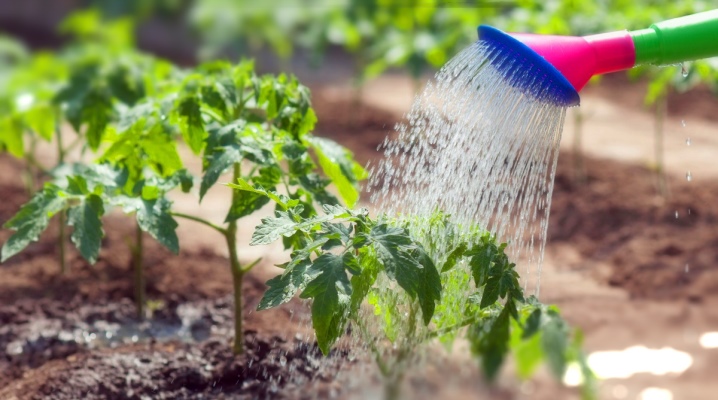
Having fresh vegetables at home, grown on your own, is considered a significant advantage, as there is complete confidence in their quality and safety. For most salads and homemade preparations, tomatoes are indispensable. To grow a good harvest of tomatoes, you need to choose a stable and high-quality variety, find a place for the future garden, and organize proper care.
Watering tomatoes is the key to their successful growth and development, and in the future - and a bountiful harvest, so it is important to know what watering methods are and how to properly carry out this procedure.
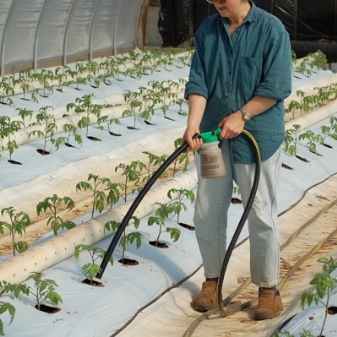

How often should you water?
Each agricultural crop has its own characteristics of cultivation, so the summer resident should know all the nuances to obtain the maximum yield with minimal investment. To grow tomatoes on the street, it is worth preparing the garden by pre-fertilizing the soil. Tomatoes are sun-loving plants; for their proper growth and high-quality ripening, you need to look for an open place on the site. In addition to the sun, it is important to give the plant watering, without which there will be neither developed bushes nor a good harvest.
There are certain norms for the temperature of irrigation water, its amount, depending on the time of day, air temperature and humidity. Watering tomatoes is not a difficult undertaking, but in order to obtain the desired result, the gardener must know the basics that will optimally distribute water resources on the site. After planting, the plant is watered at such intervals that the soil remains moist. In hot summer weather, when it does not rain for a long time, watering can be carried out every day, but often summer residents irrigate the beds 2-3 times a week.
It is worth paying attention to the period of plant development.... Watering after planting is carried out in a week, when the bushes take root in a new place and grow. After planting and the beginning of active growth, the frequency of watering decreases, but the amount of moisture increases: it is recommended to add 2-3 buckets per square meter. It is important to pay attention to tomatoes at the time of bud ovary and the beginning of flowering. In the process of flowering, tomatoes need less moisture, so the optimal amount will be 1.5-2 buckets 2 times a week. After the end of flowering and pinching, fruits begin to set. At this point, it is worth again increasing the amount of applied liquid to 3-5 liters per bush.
You can stop active watering at the stage of fruit ripening. To avoid problems with the development of fungal diseases, it is recommended to stop regularly watering the beds. You can keep moisture in the soil as much as possible by regularly removing weeds and filling the moist soil with dry soil. After hilling, moisture stays in the soil longer and can nourish plant roots well.
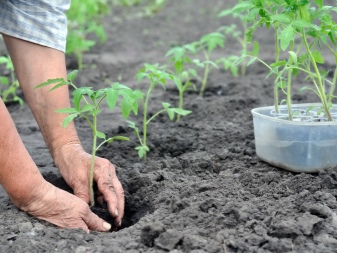

What time of day is it better to water?
There are irrigation rates for almost every crop in the garden, which include recommendations for the timing of the application of moisture to the soil. Tomatoes, like many other plants in the garden, are recommended to be watered early in the morning or in the evening. Such a framework is caused by the degree of activity of the sun's rays. It is not recommended to irrigate tomatoes in clear and hot weather, due to the rapid evaporation of moisture and the possibility of burns if water gets on the foliage.
Morning watering is considered favorable for growing in an open bed, especially in conditions when the air temperature drops significantly at night. Moisture introduced in the morning provides nutrition to the plant and allows you to accumulate everything you need for the whole day. When grown in a greenhouse, watering in the morning may be less effective, as it causes a strong increase in the level of humidity in the room, and gradually the moisture evaporates from the ground, leaving the plant in the evening with a liquid deficit.
Evening application of moisture to open beds will be suitable if the temperature does not drop significantly at night and the roots do not experience discomfort. In a greenhouse, evening watering is considered the most successful, as it allows you to start all the processes of growth and development of culture. A plus can be considered that moisture does not evaporate, since the ambient temperature is moderate, the plant has enough time for photosynthesis and distribution of the organic raw materials accumulated during the day on foliage and fruits.
In warm weather and optimal conditions for tomato growth, the humidity level can drop significantly in the morning, and there will be a need for a little additional watering.

Root or leaf?
Any plant can be watered in several ways, each of which has its own advantages and disadvantages. In the case of tomatoes, there are two options for adding moisture.
- At the root. Water is poured near the trunk of the plant in small portions, but constantly, as a result of which the roots are well nourished, and the foliage and other parts of the plant remain dry. The best option for this irrigation method is drip irrigation or a method with partially buried plastic bottles.
- Top to the tops. Watering with sprinkler, watering can, hose, when the whole tomato bush is moistened. Some summer residents are sure that this culture does not like when its leaves get wet, but in fact, any plants that can develop in open ground quite calmly transfer drops of water on foliage and other green parts. This method is recommended for use in open beds, where there is wind and sun, allowing you to dry tomatoes in the shortest possible time. For a greenhouse, this option is considered less successful, since it significantly increases the risk of fungal diseases.
Having the opportunity to grow a crop in different conditions, it is necessary to correctly select the methods of introducing moisture. Any method can be used on the garden bed, in the morning and in the evening it is possible to irrigate the entire plant, but in the afternoon, if urgently needed, you can add moisture to the root.
In a greenhouse, it is better to dwell on the method of soil moistening, which will minimize the risks associated with various diseases.
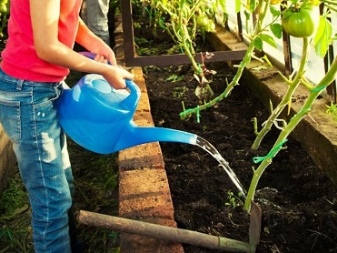

Features of water
In order for a tomato bush to grow well and develop correctly, it needs water and heat. By choosing a suitable location on the site, you can provide a sufficient amount of sunlight. Water can be used in different ways, preparing it or not using any additional preparations. To obtain strong and healthy shrubs, it is recommended to use water, the temperature of which is + 20 ... 22 ° C depending on weather conditions.
Some gardeners are confident that using cool water will harden the plants and allow them to be stronger, more resilient and produce better crops. Both approaches can be used, but it is worth focusing on the variety of tomatoes. If tomatoes are resistant varieties, then cruder methods can be applied to them, not to defend or heat the water. If a plant from a new selection is still poorly adapted to the area, then it is better to be more delicate with it, defending the water and heating it in the sun to the desired temperature.

Basic methods
The process of watering crops in the garden can be carried out by different methods, and they largely depend on the size of the site, the size of the beds, the free time of the summer resident and his financial capabilities. The easiest way to water the beds was and remains a hose, thanks to which it is possible to add the right amount of moisture without using expensive fixtures. Despite the convenience, this method also has disadvantages in the form of soil erosion, excessive waste of liquid and uneven wetting of the plantings in the garden. After moistening the area with a hose, it is necessary to loosen the soil and collect it in small mounds near the base of the bushes. Hilled plants will retain soil moisture longer, which means that the number of waterings per week can be reduced.
There is another inexpensive but effective way to water tomatoes through plastic bottles. The technique is very simple: you need to prepare plastic containers in an amount that matches the tomato bushes. 2-4 holes are punched in the lids, and the bottom is cut off. The bottle itself is buried about half of the bush. To prevent the holes in the nose from clogging, it is necessary to wrap this part with a nylon sock or tights. The bottles are filled with water, which gradually seeps into the soil, nourishing the roots. Thanks to this irrigation option, tomatoes receive a source of stable moisture and can actively grow and develop.
The topsoil is not moistened, so there is no need to huddle the bushes after watering. In addition to the above methods, there are other options for adding moisture to the soil with tomatoes.
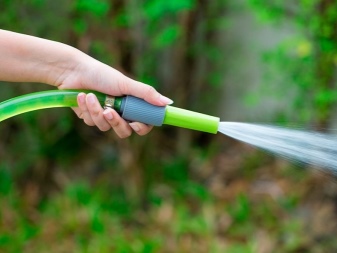
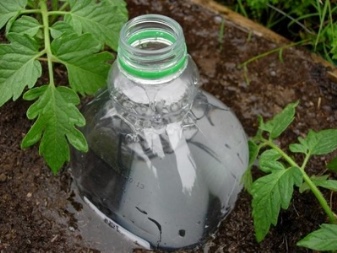
Drip
One of the best options for watering any garden crop is drip irrigation. Thanks to the system of uniform constant application of moisture to the soil, plants develop better and faster. In order to be able to water tomatoes in this way, it is necessary to install piping and specialized mechanisms on the site, thanks to which it is possible to regulate the degree of water supply, set the operating time, if necessary, or completely turn off the system. Despite a number of advantages of this irrigation method, not all summer residents choose it, since it requires quite significant financial investments to purchase and install the system. Further use of the elements of the drip irrigation system will not be costly, but the entry fee makes many people think about alternative methods.
The drip irrigation system has proven itself especially effective in greenhouse conditions when irrigation is carried out without the presence of a person., while there is no risk of waterlogging the soil or affecting too much the humidity level in the room, but the plant receives the desired moisture and can fully develop.
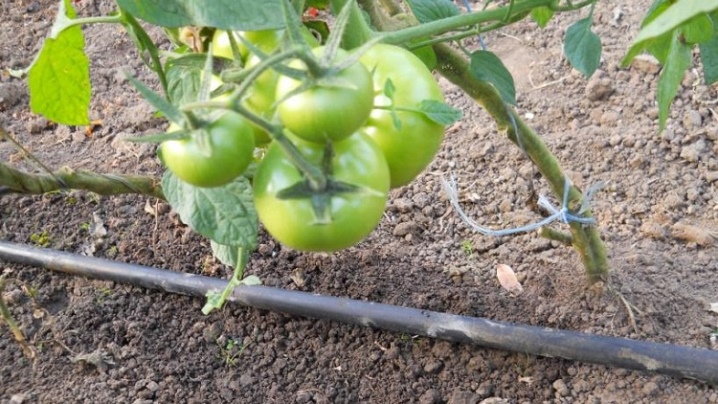
Into the hole
Summer residents who do not want to spend time and money on installing a drip irrigation system, buying hoses and arranging other irrigation options can choose a simple and reliable method in which water is delivered to tomatoes using a watering can. To prevent moisture from spreading throughout the garden, a hole is made near each bush after planting - a depression, where water and fertilizers are later poured in.
The method is very simple and quite effective, since you can accurately calculate the amount of water for each bush, use fertilizers in the process of moisturizing. Of the minuses, one can only note the need to carry a heavy watering can many times until all the bushes are watered. If the bed is small, then this option can be very convenient.
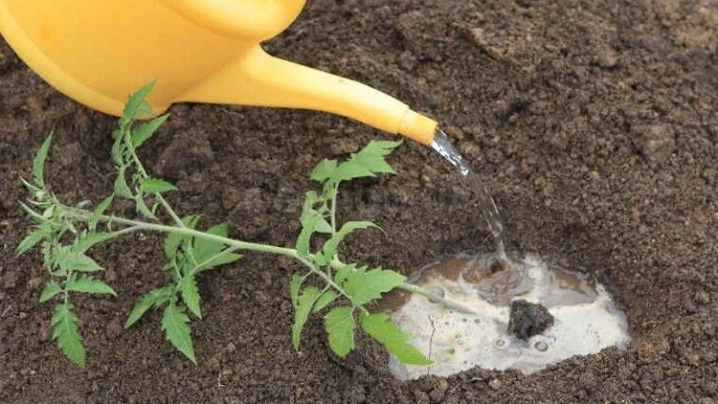
Arychny
To find a cross between drip irrigation and irrigation into the well, you can use the irrigation ditch method. Its peculiarity is that between the rows of tomatoes it is necessary to make a depression into which water will be supplied during irrigation. The depth of the trench should be about 10 cm so that water does not flow out and spread over the bed.The advantage of this method is its ease and the ability to well saturate the soil on the site.
There are also disadvantages to this method, which include soil erosion, exposing the roots of seedling bushes, waste of excess water in case of destruction of the trench by water.
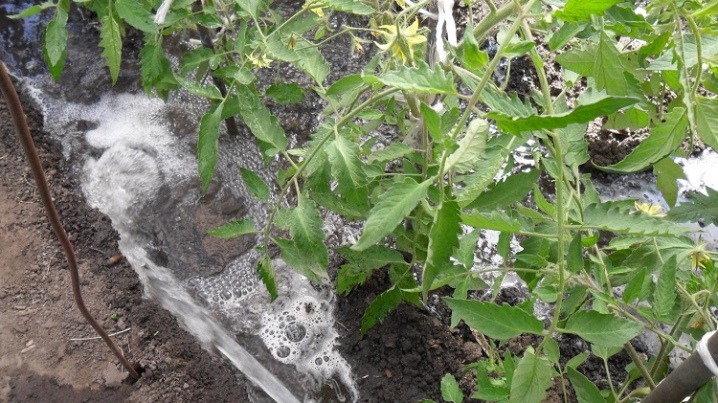
How to properly water tomatoes?
In the process of growing tomatoes, it is important to pay attention to the care of the seedlings in order to get a good harvest in the end. Once the seedlings have been planted in the ground, it is necessary to water them frequently, stimulating the growth of the root system. Watering daily in dry weather or adding moisture 3-4 times a week under comfortable conditions will allow the bushes to settle in a new place and grow. After 2 weeks after planting the tomatoes, watering is slightly reduced, but remains constant. It is recommended to add useful substances to the soil with water on a monthly basis: nitrogen and calcium.
The irrigation system changes for the flowering period, when the frequency of procedures is reduced to 2-3 times a week, and each bush receives on average about a liter of moisture. During the period of fruit formation, it is necessary to change the method of water application, using only watering at the root or in the hole. By the time the tomatoes are actively growing, it is important to increase the number of watering again, carrying them out in 1-2 days, adding 2 liters of water under the bush. When ripe fruits appear on the plants, the irrigation is reduced by 2 times, watering the tomatoes 3 times a week with 1-1.5 liters of water under the plant.
As soon as the tomatoes enter the active fruiting phase, the introduction of moisture is gradually reduced, and by the time the uppermost fruits ripen, it can be completely stopped, since the bush no longer absorbs so much moisture and can find the necessary liquid for itself. Before freezing, it is recommended to collect all the fruits and eliminate the garden bed so that pests and diseases do not develop on the seedlings. You can grow tomatoes not only in the country, a greenhouse and a balcony are well suited for this.
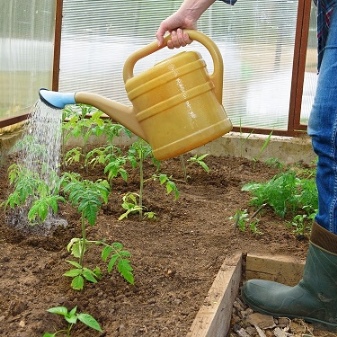
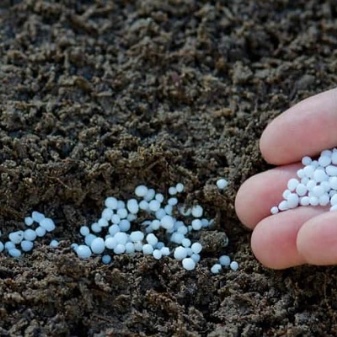
On the balcony
To grow tomatoes on the windowsill at home, you need to purchase a suitable container, soil and good seeds. It is recommended to choose low-growing varieties that take up little space and do not have a very developed root system. Initially, it is necessary to plant seeds, germinate them until several leaves appear, and then transplant them to the main place.
Watering sprouts and young seedlings is carried out small, but frequent, the soil should be moist all the time. In order for the bushes to grow healthy, they are tempered by opening a window for a couple of hours a day. After landing on the balcony, the windows are shaded, and the room temperature is maintained in the range of + 18 ... 20 ° C. As soon as the seedlings have taken root in a new place, the shading is removed. Watering is carried out as needed, as soon as the soil begins to dry out, after which it is necessary to loosen the soil.
By the time of fruiting, the introduction of moisture is reduced, it is recommended to leave a little dried out soil in order to protect the bushes from diseases. For the full growth of the culture, it is fertilized and helped in pollination by opening windows and attracting insects.

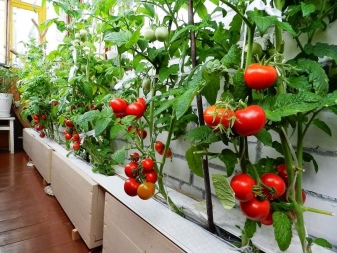
In the greenhouse
Growing tomatoes in a greenhouse is in many ways similar to the previous option, but in this case any varieties can be used, since large plants can also be placed here. It is better to install drip irrigation for a closed room, since it will saturate the soil without overmoistening the air, and can be increased or decreased depending on the temperature.
In order for tomatoes to grow well in a greenhouse, it is important to maintain a temperature of + 18 ... 20 ° C there, regularly carry out air exchange and keep the soil moist. In addition, do not forget about feeding, which will allow the plants to be stronger and more resistant.
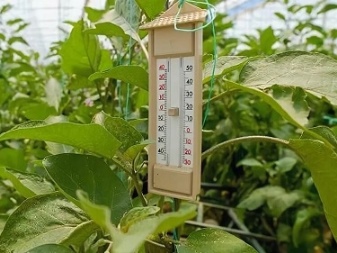
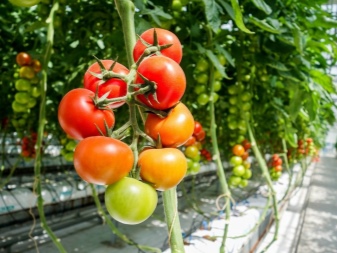
In the open field
In the garden there is an opportunity to allocate any amount of land for a garden bed, to plant a wide variety of varieties, to carry out any of the possible methods of irrigation.Depending on the available factors, each summer resident chooses how much and how to water the garden, since nature itself helps him from time to time. Thanks to natural moisture, the presence of wind and sun, caring for tomatoes in the garden will be much easier, but it is still necessary to comply with the basic requirements for watering.
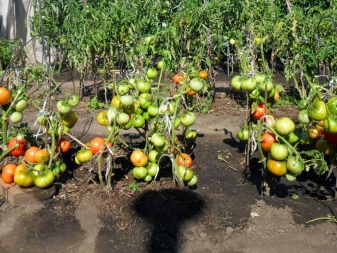
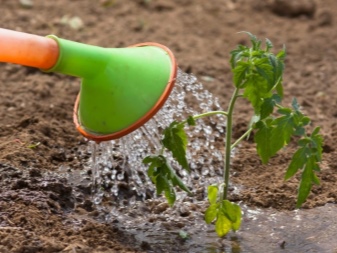
Combination with dressings
Growing tomatoes requires the summer resident not only to ensure timely watering and harvesting, but also to make additional fertilizing. Thanks to fertilizers, plants receive the necessary trace elements, which are lacking in the soil. For the full growth of tomatoes, you can use additives by diluting them in water and pouring them directly under the bush. The most suitable useful ingredients would be:
- potassium permanganate;
- Braga;
- kvass;
- curdled milk;
- ash solution;
- eggshell;
- compost;
- chicken droppings.

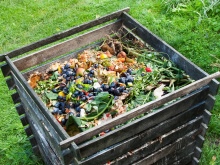

Most summer residents have such funds, but alternative options can also be used. The easiest way is to dilute superphosphate and treat all the bushes with it to provide a supply of all the necessary elements. Another way is vermicompost, which also contains a lot of useful components that feed tomatoes. And you can also process tomatoes with Bordeaux liquid or aspirin, which will strengthen the plants and protect them from pests and diseases.
In the event of the appearance of a fungus, a remedy will help to escape from it. "Trichopol", which effectively fights the disease, while not harming the plant itself. If there is a need to strengthen tomato bushes, to strengthen their immunity, then fertilizer can come to the rescue. "Zdraven"... It is produced in liquid form, therefore it mixes easily with water and is applied to the soil with irrigation.
The application of fertilizers in any form saturates the soil with useful substances, which give the seedlings everything they need for active growth and development, greater productivity and good taste characteristics of the fruits. The use of liquid fertilizers allows you to more effectively use the time on the site, moisturizing the soil and at the same time saturating it with useful substances. Each summer resident can independently choose between purchased and natural fertilizers, understanding the advantages and disadvantages of each of them.

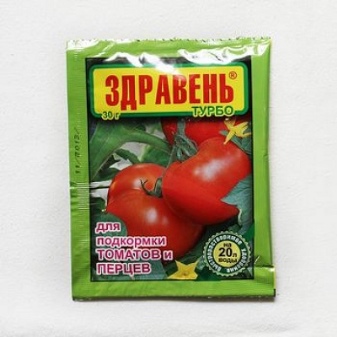









The comment was sent successfully.